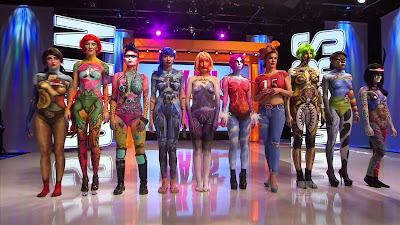Latest modern science | Lessons from Skin Wars: Have a focal point - Si Bejo Science
design graphicsI�ve been catching up with a show called Skin Wars on Hulu (new season coming on Game Show Network in April). It�s a competition reality show along the lines of Project Runway, Top Chef, and FaceOff: make something really cool, really fast. The cool thing they�re making in this case is body painting.
While watching the show, the judges often criticize a painting for not having a focal point. The artists make very intricate paintings, but when you step back, it�s all a confused mess. Nothing stands out.
I often see this with posters. Because posters tend to include way too much text, everything tends to turn into a uniform gray. Graphs tend to look alike.There�s few things that demand attention.
For instance, here�s a painting with no focal point:
Here�s another example of a painting, by Kadinsky, but this time with a clear focal point:
I�m willing to bet the thing that pops out is the dark circle in the upper left.
The reason is that the dark circle stands in contrast to most of the rest of the painting, which is light and has lots of straight lines and angles. Here�s another example of contrast being used to create a focal point:
It�s a contrasting colour, but a contrasting shape would work too. Imagine an unripened banana in the place of the red apple in the picture above. You�d still look more at the banana, because it is different.
Another simple way to create a focal point is with that most underused tool, white space:
There are lots of blue circles on the page, but the one surrounded by lots of white space is emphasized.
A third way to create a focal point is with lines:
Thanks to perspective, the strong lines of the train tracks, the top and bottom of the train cars, and the treetops all converge onto the vanishing point, which becomes the image�s focal point.
To use a focal point in a poster, you first need to decide what the most important thing on your poster than you want to emphasize. Once you have done that, use the three tips above (and many others besides!) to create a clear focal point on your poster.
External links
Dominance: Creating Focal Points In Your Design
Gestalt Principles: How Are Your Designs Perceived?
Designing with strong simple focal points
How to use focal points to enhance your photography
Top 25 mistakes artists make #2: not adding a focal point
Landscape from here; Kadinsky painting from here; apple picture from here; abstract from here.; mountains from here.
































